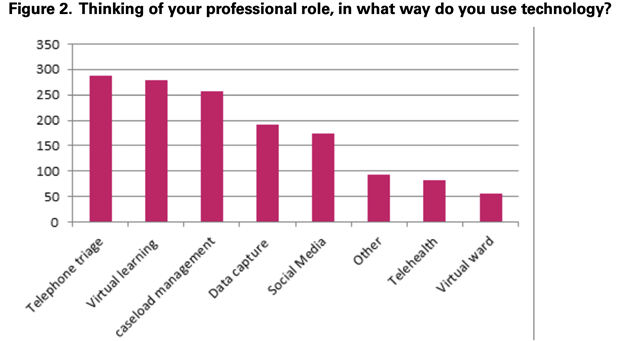Technology has invaded our lives totally and completely, becoming a part of who we are. Every industry and every niche out there has benefited (and sometimes suffered) from tech innovations. Healthcare isn’t an exception, and nor is an integral part of healthcare ― nursing.
When we talk about technology in nursing, we talk about ways that it makes the job easier and more effective. Software and hardware involved save time, money, and often lives. It allows nurses, midwives, and care staff to spend more time with patients and to do their job in a better and safer way.
Informational technology has affected nursing globally. Societies all over the world use smartphones and have constant Internet access; the popularity of wireless technology in healthcare is growing; telehealth has become a major part of healthcare delivery; AI and robotic systems are tested and implemented. The COVID-19 pandemic only speeded up the adoption of these technologies and made them more widespread all over the world.
The research regarding technology in nursing is also carried out in many countries. The population is getting older and more people are living with chronic diseases, which means more nurses are desperately needed. At the moment, the shortage of nurses is apparent in many countries. Research on technology is carried out in the hope that it will speed up or even substitute some aspects of human work, and help do more nursing with fewer people involved.
In this article, we focus on the impact of technology on nursing in the UK specifically.
The UK has a unified healthcare system: National Health Service (NHS). The NHS has strived to become more technology-savvy for years, and a lot of their plans had and continue to have a lot to do with nursing.
The NHS’s Five Year Forward View and the funding NHS received 2017-1019 aimed to embrace the technology in healthcare facilities and “exploit the information revolution”. The NHS’s Long Term Plan underlying these programs aims to make the NHS paperless, which will first of all make the work of nurses more efficient. National and local publications and Sustainability and Transformation Plans also emphasize the use of information and technology as fundamental to the transformation of the healthcare system that starts with nursing.
Basically, the UK is a good example of how technology is usually used in nursing, both in its successes and failures.
How is technology used in nursing?
The Queen Nursing Institute (QNI) works in the UK to make sure nurses, managers, and policymakers provide high-quality nursing to everyone in their homes and communities. For their Nursing in the digital age report, which was based on a survey of 534 community health professionals, they asked nurses to tell in what way they use technology in their professional role. Here are the answers they got:

www.qni.org.uk
The report also showed that:
- 67 differently named IT systems are used in community healthcare;
- 74% of community nurses find IT systems a more reliable way of working, compared to paper;
- 29% of community nurses are still working largely with paper-based systems;
- 59% of NHS trusts use telehealth systems;
- 28% of services utilise a text messaging facility to remind patients of their appointments.
Nurses widely agreed that adopting digital technology brings benefits to nursing practice and education. They used IT to communicate easier with their patients and provide care, support, and education. They also used IT to communicate with other health professionals (organize conference calls, etc.). Survey respondents described ways in which digital technology helped with healthcare delivery, which included, electronic prescribing, virtual consultations, data collection, updating patient records, referring patients to specialist services, diagnostic tools, remote monitoring, etc. Generally, technology that impacts nursing practice could be broken down into the following categories:
-
Information and Communication Technologies (ICT)
ICT incorporates various technologies that are involved in ensuring seamless communication between health professionals, as well as simplifying clinical workflow and making it more efficient. This category includes technology that collects, stores, provides, manages, and/or improves communication. Such as:
- Hospital (or care institution) information systems (HIS)
- Electronic health (EHR)/electronic medical records (EMR)
- Computerized decision support systems (CDSS)
- Telecare
- General communication support
- Systems to support process planning and/or data exchange
- Specific Apps
- Target group-specific interfaces
ICT facilitates healthcare delivery support. They change how nurses plan, deliver, document, and review clinical care, which simplifies their communication with health professionals, patients, and their families, as well as allows nurses to make clinical decisions and review diagnoses when required.
-
Robotic technologies
Robotic technologies include assistive robots and assistive social robots, with the latter being able to perform social interaction with the patients. Assistant robots take on some of the nurses’ clinical workflow, taking over physical tasks. Assistive social robots are divided into therapeutic robots, telepresence robots, service robots, and socially interactive robots. They take on more sophisticated tasks that nurses are also often responsible for. A lot of research and testing is still done in this category.
-
Monitoring/Sensor solutions
Remote monitoring and sensor solutions allow nurses to take care of their patients remotely. Solutions can be quite complex, such as Ambient Assisted Living settings, which consist of medical sensors, wireless sensor and actuator networks (WSANs), computer hardware, computer networks, software applications, and databases, all of which are interconnected to exchange data and provide services in an Ambient Assisted environment. Such settings provide and exchange numerous health information. However, there are also less complex wireless technologies in healthcare that have a very specific implication. They detect or prevent a specific risk, such as falling, analyze behavioral patterns, or monitor a specific health metric, such as blood glucose.
-
Telehealth
Telehealth has been growing in use as a way of delivering information and treatment and skyrocketed when the pandemic hit the UK, just as it did for the rest of the world. For nurses, telehealth is a standard tool for providing daily monitoring and coaching of patients with chronic diseases. According to BMJ research, this practice has helped reduce emergency department admissions.
-
Virtual Reality
Virtual Reality is a growing and very effective method of pain management. In hospital settings, pain is managed mostly using medications. However, nurses often have to stop giving out meds and spend their valuable time consoling and distracting patients in pain. While VR can’t offer human contact, it can surely provide distraction. Numerous studies have shown that VR is a useful tool for pain management in hospital settings.
-
eLearning
Remote learning opportunities have transformed medical education delivery. It became much easier to get additional information, improve qualifications, and stay constantly updated with medical news.
What are the challenges of technology in nursing?
Technology isn’t always perceived as something helpful. Often, it feels like an intrusion into caring relationships that nurses have with the patients. For many nurses, its benefits are arguable, while the necessity to spend time and effort learning new technologies (that are also regularly updated) is unavoidable. The Nursing in the Digital Age report points out that it has been challenging for the United Kingdom to adopt new technology in healthcare, and that they fell behind compared to other developed countries. The report states that there has been resistance and reluctance in adopting new technologies among nursing staff, which led to the fact that there are health facilities still relying on older forms of technology, such as fax machines and paper-based records.
The best way to overcome this problem is by introducing better education and training. It is undoubtedly challenging being caught up in a faced-paced tech environment, but no one can deny the fact that this is the present and the future of nursing. By introducing educational campaigns in different trusts, the NHS can facilitate the adoption of nursing technology. For example, in 2018, the Royal College of Nursing started the campaign ‘Every nurse is an e-nurse’. During the campaign, nurses were trained to use different digital technology, such as patient bedside technology, wearable tech, and mHealth apps. They also had discussions about data privacy and security.
Final words
Nursing involves a lot of caring, human contact, empathy, and connection. This is why it’s often hard to imagine technology taking up some of the nurse’s work and being anything other than another chore a nurse has to do. However, it’s vital to remember that nursing isn’t just about emotion and compassion. It involves real management, bureaucracy, and plenty of repetitive tasks. It also exists in times when human connection is impossible ― for example, during global pandemics. And after the patient leaves the hospital settings, they go home with only their smartphone to provide medical guidance. Today, the involvement of technology in nurses has a positive, long-lasting impact by allowing remote care and fighting the shortage of nurses.









